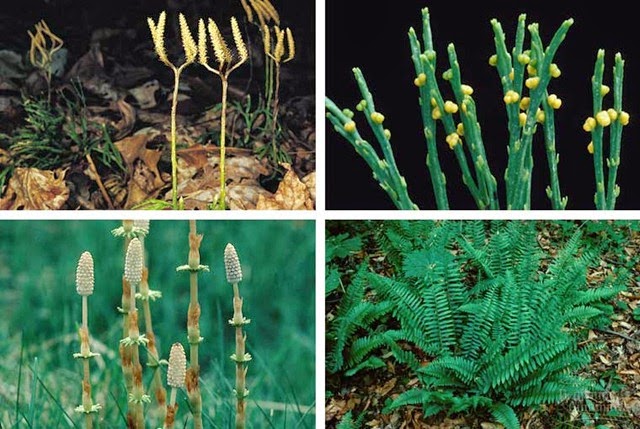Pteridophytes are a group of vascular plants that are significant in the evolutionary history of the plant kingdom as they represent the first true land plants with a well-developed vascular system. They bridge the gap between non-vascular bryophytes and seed-bearing plants like gymnosperms and angiosperms.
These plants reproduce via spores and lack seeds, which
places them among cryptogams, a category of non-seed-producing plants. The term
"Pteridophyte" is derived from the Greek words pteron
(feather) and phyton (plant), highlighting the feather-like appearance
of fern fronds, one of the most recognizable groups of pteridophytes.
Pteridophytes have a global distribution, thriving in
tropical, subtropical, and temperate regions. They are particularly abundant in
moist and shaded habitats, such as rainforests, though some species have
adapted to arid environments.
General Structure of Pteridophytes
The structure of pteridophytes is more advanced than that of
bryophytes, reflecting their adaptation to a terrestrial lifestyle. The plant
body is differentiated into roots, stems, and leaves, and they exhibit a
prominent sporophytic phase in their life cycle.
1. Roots
- Pteridophytes
possess true roots that are capable of anchoring the plant in the soil and
absorbing water and nutrients.
- The
roots often arise from underground stems (rhizomes) and are adventitious
in nature.
2. Stems
- The
stems can be aerial or subterranean. Subterranean stems are often in the
form of rhizomes.
- The
stem is vascular, with a central stele composed of xylem and phloem
tissues. The type of stele varies and includes protostele, siphonostele,
or dictyostele in different species.
3. Leaves
- Pteridophytes
exhibit two types of leaves:
- Microphylls:
Small, simple, and scale-like leaves, as seen in club mosses (Lycopodium).
- Macrophylls:
Large, complex, and divided leaves, as seen in ferns (Pteris, Dryopteris).
- Leaves
may be sterile or fertile. Fertile leaves bear sporangia (spore-producing
structures), which are often grouped into sori on the underside of the
leaf.
4. Vascular Tissue
- Pteridophytes
are the first plants to develop vascular tissues.
- Xylem
conducts water and minerals and contains tracheids.
- Phloem
conducts food but lacks companion cells, unlike angiosperms.
5. Reproductive Structures
- Sporangia
develop on specialized leaves called sporophylls. In some species,
sporophylls aggregate into structures called strobili or cones (e.g., in Selaginella
and Equisetum).
- Spores
germinate to produce gametophytes, which are independent and
photosynthetic.
Classification of Pteridophytes
Pteridophytes are divided into four major groups based on
their structural and reproductive characteristics:
1. Psilotophyta (Whisk Ferns)
- Primitive
vascular plants without true roots and leaves.
- Stem
performs photosynthesis and bears small, scale-like structures.
- Example:
Psilotum.
2. Lycophyta (Club Mosses and Spike Mosses)
- Small
plants with microphyllous leaves.
- Sporophylls
are arranged in cones (strobili) at the tips of branches.
- Some
members, like Selaginella, exhibit heterospory (production of two
types of spores).
- Examples:
Lycopodium, Selaginella.
3. Sphenophyta (Horsetails)
- Plants
with jointed, ribbed stems containing silica.
- Leaves
are small, scale-like, and arranged in whorls at nodes.
- Cones
are borne at the tips of fertile stems.
- Example:
Equisetum.
4. Pterophyta (True Ferns)
- The
largest and most diverse group of pteridophytes.
- Ferns
have large, feathery fronds that uncurl as they grow (circinate
vernation).
- Sori,
clusters of sporangia, are present on the underside of the fronds.
- Examples:
Dryopteris, Adiantum, Pteris.
Reproduction in Pteridophytes
Pteridophytes exhibit alternation of generations,
involving a dominant sporophyte phase and a gametophyte phase.
1. Sporophytic Phase
- The
sporophyte is diploid (2n), vascular, and photosynthetic.
- It
produces haploid (n) spores through meiosis in sporangia.
- In
ferns, sporangia are often grouped in sori and protected by an indusium (a
thin membrane).
2. Gametophytic Phase
- Spores
germinate to form haploid gametophytes, which are small, green, and
independent.
- The
gametophyte (prothallus) is typically heart-shaped and bears sex organs:
- Antheridia
(male organs) produce motile sperm.
- Archegonia
(female organs) produce eggs.
3. Fertilization
- Water
is essential for fertilization as the motile sperm swim to the egg in the
archegonium.
- Fertilization
produces a diploid zygote, which develops into a new sporophyte.
Importance of Pteridophytes
Pteridophytes hold ecological, economic, and scientific
significance.
1. Ecological Importance
- Soil
Stabilization: Roots bind soil, preventing erosion.
- Carbon
Sequestration: Pteridophytes play a role in the carbon cycle by
storing carbon dioxide.
- Habitat
Creation: They provide habitats for insects, birds, and other small
organisms.
2. Economic Importance
- Ornamentals:
Ferns like Nephrolepis and Adiantum are popular ornamental
plants.
- Medicinal
Uses: Some species, such as Equisetum, are used in traditional
medicine to treat kidney and bladder disorders.
- Industrial
Applications: Horsetails, rich in silica, were historically used for
polishing metal.
- Edible
Uses: Some species, like fiddlehead ferns, are consumed as vegetables
in many cultures.
3. Scientific Importance
- Evolutionary
Studies: Pteridophytes provide insights into the evolution of vascular
tissues and alternation of generations.
- Environmental
Indicators: They are bioindicators of moisture and pollution levels.
- Fossil
Fuels: Extinct pteridophytes, such as lycophytes and horsetails from
the Carboniferous period, contributed to the formation of coal deposits.
Conclusion
Pteridophytes are a vital group of plants that have played a
significant role in the evolutionary history of terrestrial flora. With their
unique vascular system, alternation of generations, and ecological
adaptability, they mark the transition from simpler bryophytes to complex seed
plants. Their ecological roles in soil conservation, carbon sequestration, and
habitat creation, along with their ornamental, medicinal, and scientific
importance, underscore their value to both nature and humanity. As living fossils
of a bygone era, pteridophytes continue to captivate scientists, ecologists,
and horticulturists alike.











_Tode_1013949.jpg)
0 Comments